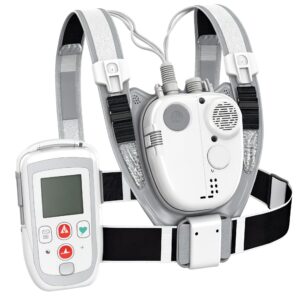Wearable Defibrillators in the UK: A Life-Saving Guide
When someone is at risk of sudden cardiac arrest (SCA) but not yet ready for an implantable cardioverter defibrillator (ICD), wearable cardioverter defibrillators (WCDs) can provide life-saving protection. This blog explores how WCDs work, who they’re for, and what options exist in the UK, especially for people navigating post-cardiac event recovery.
What Is a Wearable Cardioverter Defibrillator?
A wearable cardioverter defibrillator is a medical device worn externally, usually under clothing, that continuously monitors the heart’s rhythm. If a life-threatening arrhythmia like ventricular fibrillation is detected, the device delivers an electric shock to restore a normal rhythm. WCDs differ from public access AEDs and surgically implanted defibrillators in that they offer non-invasive, temporary protection.

Who Might Be Prescribed a WCD?
WCDs are typically prescribed for patients at high risk of SCA but who may recover cardiac function over time or are awaiting further treatment. This includes:
- Post-heart attack patients with reduced ejection fraction
- Individuals recently discharged from heart failure hospitalisation
- Those awaiting ICD surgery or transplant evaluation
- Patients with temporary contraindications to surgery or anticoagulation
How WCDs Work: Key Features
- Continuous ECG Monitoring: Tracks heart rhythm 24/7
- Audible Alerts: Warns patients if an arrhythmia is detected
- Automated Shock Delivery: If the patient does not respond to warnings, the unit will deliver a therapeutic shock.
- Data Collection: Captures diagnostic data for cardiologists to review
- Non-Invasive: Worn like a vest under clothing with no surgery required
Clinical & Regulatory Information in the UK
WCDs are increasingly used in specialist cardiac centres, with growing interest from NHS Wales and private cardiac specialists, though NHS England funding remains limited. Some UK NHS trusts deploy devices like the ZOLL LifeVest within specialist cardiac programs, but coverage varies regionally.
While NICE has produced guidance on digital health technologies, there’s no formal NICE guideline specifically endorsing WCDs. Regulatory oversight falls under the MHRA (Medicines and Healthcare Products Regulatory Agency).
Evidence & Outcomes
The VEST trial (published in JAMA, 2018) explored WCD use after myocardial infarction. It suggested trends toward reduced arrhythmic death but did not reach statistical significance. Further observational studies and registry data highlight WCD potential, though definitive UK-specific RCTs remain limited.
Implantable Cardioverter Defibrillators (ICDs): A Permanent Option
For patients requiring long-term protection from sudden cardiac arrest (SCA), ICDs offer a reliable, implanted solution. These small devices are surgically placed under the skin, typically near the collarbone, and monitor heart rhythm continuously.
Key Benefits of ICDs:
- Continuous Monitoring: Like WCDs, ICDs provide around-the-clock rhythm tracking.
- Automatic Response: If a life-threatening rhythm is detected, the ICD delivers a shock to restore normal rhythm.
- Long-Term Solution: Ideal for patients with chronic risk of arrhythmia or recurrent cardiac episodes.
ICDs are recommended after thorough evaluation by cardiologists and are supported by UK clinical guidelines such as NICE TA314. Unlike wearable defibrillators, ICDs require surgical implantation and ongoing cardiology clinic monitoring, often guided by British Heart Rhythm Society standards.
Limitations of WCDs
- Cost: Often higher than public access defibrillators
- Comfort: Some patients report discomfort from daily wear.
- False Alarms: As with any device, there’s potential for unnecessary alerts.
Public AEDs vs. WCDs: Know the Difference
While wearable cardioverter defibrillators (WCDs) are prescribed medical devices for patients with a confirmed cardiac risk, automated external defibrillators (AEDs) are designed for rapid, public-access use during sudden cardiac arrest (SCA) emergencies in workplaces, public spaces, and community environments.
Unlike WCDs, which are worn continuously and respond to the individual’s heart rhythm, AEDs are intended for use by bystanders or trained staff during unexpected cardiac events. They’re essential for environments where high footfall, physical activity, or isolated access could delay emergency services.
For organisations, the Mediana HeartOn A15 AED delivers advanced technology and excellent value, including CPR feedback, IP55-rated durability for mixed indoor-outdoor environments, and dual-language prompts, making it an ideal alternative for public or maritime readiness.
Key distinctions include:
- Scope of Use: AEDs are placed in public areas and can be used by anyone trained or untrained, whereas WCDs are worn by specific individuals.
- Design & Accessibility: Public AEDs are wall-mounted and visible, allowing rapid use during emergencies; WCDs must be worn properly to be effective.
- Regulatory Context: Public AEDs support compliance with safety standards (e.g., CQC, PUWER, etc.), while WCDs are managed under NHS cardiac specialist channels and prescribing guidance.
By choosing a reliable public AED like the Mediana HeartOn A15, organisations gain broader coverage and communal protection. It complements scenarios where wearable devices might not be practical.
Alternative Solutions for Organisations
If you’re seeking a parallel solution, we offer AED bundles and storage solutions, but wearable defibrillators should be sourced via specialist medical suppliers and prescribed by your cardiologist.
Want to learn more about where AEDs make the biggest difference? Check out our in-depth blog on Defibrillators at Sea: Ensuring Safety Aboard Ships & Offshore Installations to understand how devices like the iPAD SPR are already protecting lives in some of the UK’s most challenging environments.
Contact Us
If you’re exploring ways to improve defibrillator readiness in your organisation or community, our expert team is here to help. We’ll walk you through selecting the right AED, setting up storage and signage, and ensuring full regulatory compliance. Whether you’re outfitting a construction site, office, school, or marine vessel, we can support you with tailored advice and reliable products.
Get in touch today, or browse our full range of defibrillators and accessories to get started.


